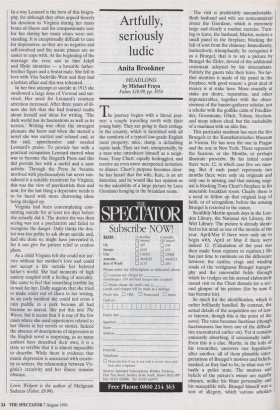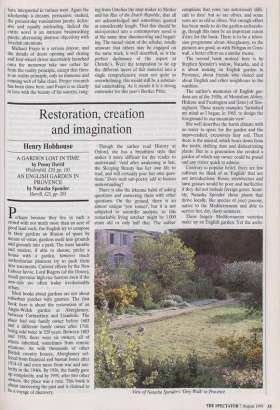Artfully, seriously ludic
Anita Brookner
HEADLONG by Michael Frayn Faber, £16.99, pp. 3954 The journey begins with a literal jour- ney: a couple travelling north with their young baby. They are going to their cottage in the country, which is furnished with all the comforts of a typical low-grade English rural property: mice, damp, a defaulting septic tank. They are met, unexpectedly, by a man who introduces himself as a neigh- bour, Tony Churt, equally bedraggled, and receive an even more unexpected invitation to dinner. Chures purpose becomes clear: he has heard that the wife, Kate, is an art historian, and he would like her opinion as to the saleability of a large picture by Luca Giordano hanging in the breakfast room. The visit is predictably uncomfortable. Both husband and wife are noncommittal about the Giordano, which is extremely large and clearly a routine exercise. Turn- ing to leave, the husband, Martin, notices a small panel in the fireplace, blocking the fall of soot from the chimney. Immediately, instinctively, triumphantly, he recognises it as a Bruegel, that is to say a picture by Bruegel the Elder, devoid of the additional consonant adopted by his descendants. Politely the guests take their leave. No fur- ther mention is made of the panel in the fireplace, with good reason: a great deal of money is at stake here. More crucially at stake are desire, reputation, and other imponderables, together with the obses- siveness of the hunter-gatherer scholar, not a scholar with the godlike calm of Friedlan- der, Grossmann, Gliick, Tolnay, Stechow, and many others cited, but the excitability of a madman with an idee fixe.
This particular madman has seen the five Bruegels in the Kunsthistorisches Museum in Vienna. He has seen the one in Prague and the one in New York. These represent the Seasons, or the Months, or perhaps illustrate proverbs. By his initial count there were 12, in which case five are miss- ing. But if each panel represents two months there were only six originals and only one is missing, and that missing origi- nal is blocking Tony Churt's fireplace in his miserable breakfast room. Clearly there is a need to follow up that original leap of faith, or of recognition, before the missing Bruegel is restored to the canon.
Stealthily Martin spends days in the Lon- don Library, the National Art Library, the Witt Library. The picture is already identi- fied in his mind as one of the months of the year, April/May if there were only six to begin with, April or May if there were indeed 12. (Calculation of the year was then made from equinox to equinox.) He has just time to ruminate on the difference between the castles, crags and winding roads of the vertiginous Bruegel topogra- phy and the uneventful fields through which he trudges on his second elaborately casual visit to the Churt domain for a sec- ond glimpse of his picture (for by now it has become his). So much for the identification, which is rather brilliantly handled. By contrast, the actual details of the acquisition are of less- er interest, though this is the point of the novel. The tone becomes facetious (though facetiousness has been one of the difficul- ties encountered earlier on). Yet it remains eminently absorbing, if occasionally ludic. Even this is a clue. Martin, in the toils of his researches, uncovers one hypothesis after another, all of them plausible inter- pretations of Bruegel's motives and beliefs, masked, as they had to be, in what was vir- tually a police state. The motives and beliefs of the picture's owner are equally obscure, unlike his blunt personality and his susceptible wife. Bruegel himself was a sort of allegory, which various scholars have interpreted in various ways. Again the scholarship is dreamy, persuasive, exalted, the present-day ruminations jaunty, defen- sive and equally misleading. Indeed the entire novel is an intricate brainwashing puzzle, alternating abstruse objectivity with feverish intentions.
Michael Frayn is a serious farceur, and the details of doors opening and closing and four-wheel drives uncertainly launched onto the motorway take one rather far from the reality principle, except that there is no reality principle, only an immense and cunning web of false clues. Proper research has been done here, and Frayn is so clearly in love with the beauty of his sources, rang- ing from Ortelius the map-maker to Motley and his Rise of the Dutch Republic, that all are acknowledged and sometimes quoted at considerable length. That this should be incorporated into a contemporary novel is at the same time disconcerting and beguil- ing. The tunnel vision of the scholar, totally unaware that others may be engaged on the same track, is well described, as is the perfect diplomacy of the expert at Christie's. Were the temptation to tie up the different layers of this material into a single comprehensive scam not quite so overwhelming, this would still be a substan- tial undertaking. As it stands it is a strong contender for this year's Booker Prize.



























































 Previous page
Previous page